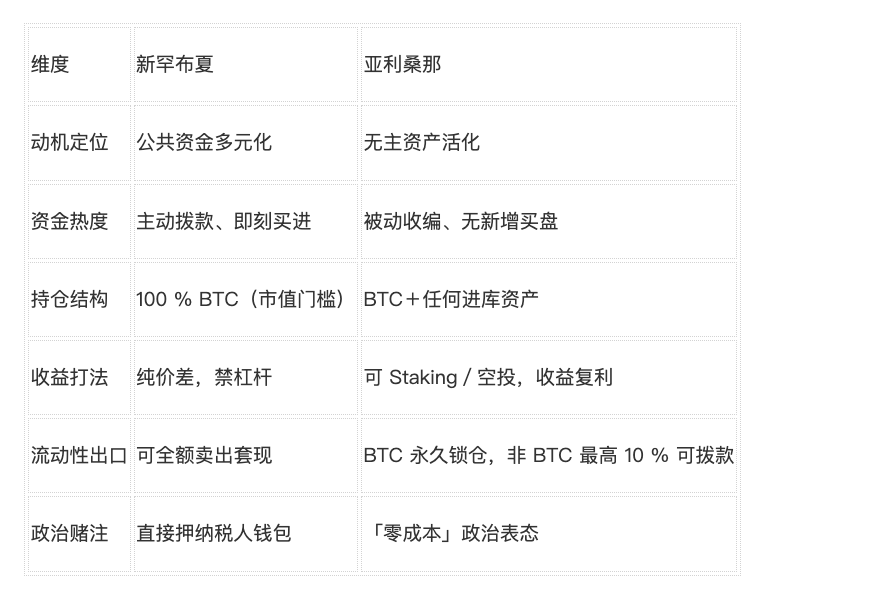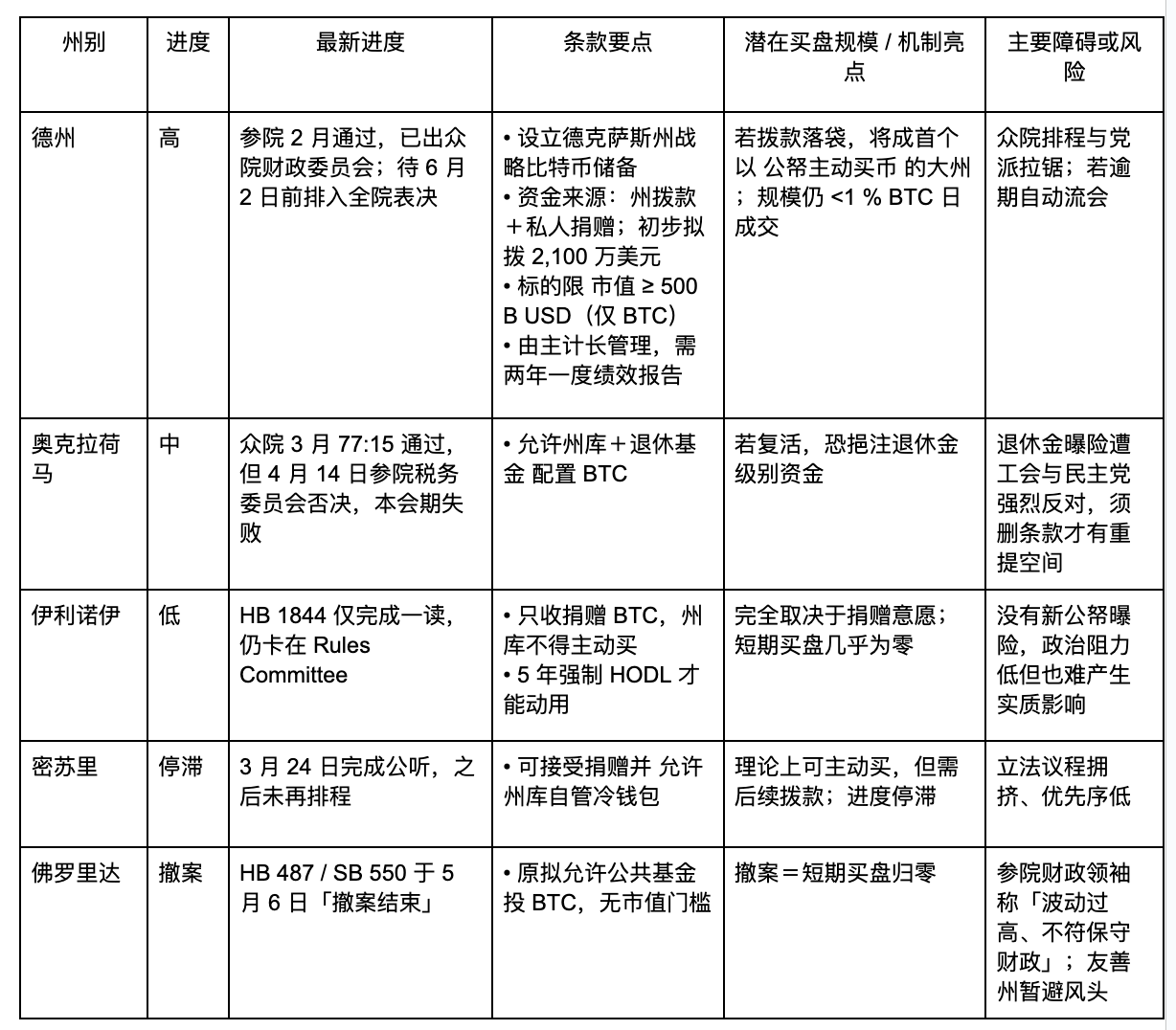Starting at the state level, two states have already included Bitcoin in their reserves.
Author: WOO X Research
For cryptocurrency users, the most anticipated policy that could be implemented after Trump's election is definitely the adoption of Bitcoin as a strategic reserve by the United States. However, more than three months after the election, the central government has yet to take action. Is the hope for Bitcoin as a strategic reserve shattered? Not at all. In fact, within just the past week, two states in the U.S. have officially written Bitcoin into their state treasury, with five more states in the legislative stage, ready to act. The differences in funding sources, allocation limits, and custody models adopted by each state reflect varying tolerances of local governments towards "high volatility, decentralized assets." This article critically analyzes who is genuinely laying the groundwork, who is engaging in political theatrics, and where potential black swans may be lurking. It also speculates on the next impact of this "official HODL" wave on market liquidity and narrative premiums.
How are New Hampshire and Arizona playing this?
In just 48 hours, New Hampshire and Arizona completed legislation and received the governor's signature, marking the beginning of a new era for state treasury holdings. The paths and risk control mechanisms adopted by the two states are almost diametrically opposed, revealing the trade-offs under different political and economic goals.
New Hampshire HB 302 | Active allocation, single asset BTC, set ceiling
New Hampshire's approach resembles "Treasury-level asset diversification." The provision authorizes the state treasurer to convert up to 5% of the general fund and rainy day fund directly into digital assets with a market capitalization exceeding $50 billion for a continuous year, which effectively means only Bitcoin qualifies.
Legislators emphasize that this 5% cap serves as a safety valve: if the financial pool expands or contracts, the holding limit will adjust accordingly to avoid a one-time heavy investment. However, the provision is vague on whether "forced proportional selling occurs when the fund size shrinks," leaving an accounting gray area.
In terms of custody, HB 302 offers three options:
State treasury self-managed multi-signature cold wallet;
Entrust to a licensed "Special Purpose Depository Institution (SPDI)" or other regulated banks;
Hold through a Bitcoin ETF approved by the SEC or NFA.
If opting for a cold wallet, self-management must meet seven technical standards, including geographic dispersion, hardware isolation, and annual penetration testing, to minimize the risk of private key leakage. However, if choosing an ETF, the state treasury only receives a trust certificate—transparency returns to traditional financial ledgers, contradicting the on-chain advantage of "visibility and traceability."
In terms of information disclosure, the state treasurer must list holdings, costs, and unrealized gains and losses in quarterly financial reports; supporting legislators have verbally committed to "publishing on-chain addresses" to enhance transparency, but this is not written into mandatory provisions. The provision also completely prohibits leverage, borrowing, or collateralization, aiming to reduce credit risk to zero, at the cost of giving up all yield-enhancing means.
New Hampshire is taking the "Treasury-level asset diversification" route—small proportion, single asset, extremely conservative—but it also directly ties taxpayers to the Bitcoin price rollercoaster.
Arizona HB 2749 | Passive acquisition, zero tax burden, allows Staking
Arizona views "not using a dime of tax money" as its core selling point. The new law allows the state government, after a three-year search period, to transfer unclaimed crypto assets (including those with incomplete private keys but identifiable) into a newly established "Bitcoin and Digital Asset Reserve Fund."
From this point on, the fund can also legally accept all derived airdrops and staking rewards, creating a compounding cycle without needing to request additional budget from the legislature.
Even bolder is the scope of assets; the provision imposes no market capitalization or liquidity thresholds—any asset that falls into the hands of the state can be included. Theoretically, everything from Bitcoin to meme coins with daily trading volumes of only a few tens of thousands of dollars could be acquired; the state government diversifies risk through a varied portfolio but also exposes itself to high-risk areas of price manipulation in small coins.
Custody must be entrusted to compliant institutions licensed in Arizona; during this period, assets are allowed to participate in full-chain staking to earn returns. This makes the state treasury an active player on-chain for the first time; if validators are penalized (slashing) or smart contracts fail, the losses will also fall on the public sector's accounts.
In terms of liquidity management, HB 2749 only allows the state treasurer to convert up to 10% of non-Bitcoin holdings into cash to subsidize general fund expenditures; the BTC portion is locked by legislation and cannot be touched unless further legislation is passed. Information disclosure adopts a "annual report + legislative appropriation for use" dual safeguard, but there is no mandatory public disclosure of on-chain addresses, resulting in lower transparency than decentralized standards.
Arizona treats BTC as "found money earning interest," leveraging staking and airdrops to amplify idle value, cleverly avoiding taxpayer scrutiny, but also placing the state treasury on the front lines of on-chain operational risks.
What should we, as investors, pay attention to?
Purchase scale: Even if NH is fully invested, it only amounts to $300-400 million, which has limited impact on BTC liquidity; AZ's initial amount is even less significant.
Narrative boost: Official endorsement + "zero tax burden" story is enough to elevate short-term sentiment, but cash flow will not immediately flood in.
Risk control comparison: NH trades "cap + cold wallet" for low returns; AZ trades "no-cost staking" for high technical/contract risks, and neither model is a panacea.
Black swan: If BTC experiences a single-day drop of > 20%, NH may be forced to write down its 5% holdings due to accounting evaluations; AZ will face additional risks from staking slashing or custody contract errors, which could allow opposition in the state legislature to overturn decisions.
Core Differences

What is the situation in other states?

The key is Texas: If successful in scheduling and appropriating funds before June 2, it will mark the first case of "large-scale public fund purchasing of coins," amplifying the narrative. Conversely, if even Texas encounters obstacles, it will be even harder for subsequent states to mobilize.
Purchase ≠ Legislation: Even if the bill passes, budget appropriations still require separate approval; investors should continue to track appropriation bills and the public disclosure of on-chain wallet addresses.
Terms vary greatly: From Texas's "active appropriation + single asset BTC" to Illinois's "pure donation + five-year lock-up," the risk/reward curves differ significantly, and subsequent states may choose to mix and match the best elements.
Conclusion: Does purchase scale bring substantial effects? Sentiment first
New Hampshire allows the state treasury to convert up to 5% of the general/rainy day fund into Bitcoin, with the state fiscal year budget being less than $7 billion; even if fully invested, it is roughly estimated to be only $300-400 million. Arizona, on the other hand, passively acquires unclaimed crypto assets for over three years, making it difficult to even reach the billion-dollar mark in the short term. In contrast, Bitcoin's 24-hour spot trading volume has long maintained between $60-70 billion; even if state purchases enter the market in one go, they would only account for 0.1% of daily market liquidity. The volume of legislation is greater than the actual amount of funds; price reactions are more about sentiment trading rather than an imbalance in spot supply and demand.
The bills from the two states were signed on May 6 (NH) and May 8 (AZ); Bitcoin rose from $96K to nearly $100K within 48 hours, with a weekly increase of about 3%. Axios statistics show that during the same period, social media discussions related to the keyword "Bitcoin Reserve" increased by over 240% week-on-week. However, trading volume did not expand correspondingly, indicating a "headline rally" rather than a significant absorption of spot supply.
Additionally, Glassnode points out that the 30-day actual annualized volatility has fallen back to 45-50%, reaching a low range since 2021, but the long-term historical range often exceeds 60%, still incomparable to traditional assets. If a Black Swan event occurs with a single-day drop of > 20%, New Hampshire's 5% holdings will immediately face devaluation pressure, while Arizona will also bear the additional risks of staking slashing or custody contract errors.
The official HODL narrative has been "half-cooked" by the market; the real determinants of market conditions are the speed of legislative implementation and the actual amount of fiscal appropriations. Only when legislation, appropriations, and on-chain addresses are all established simultaneously can it be said that the primary reason for the rise in Bitcoin prices can be attributed to state strategic reserve funds.
免责声明:本文章仅代表作者个人观点,不代表本平台的立场和观点。本文章仅供信息分享,不构成对任何人的任何投资建议。用户与作者之间的任何争议,与本平台无关。如网页中刊载的文章或图片涉及侵权,请提供相关的权利证明和身份证明发送邮件到support@aicoin.com,本平台相关工作人员将会进行核查。




